By Rob English
Download Ice Dams 101 (PDF)
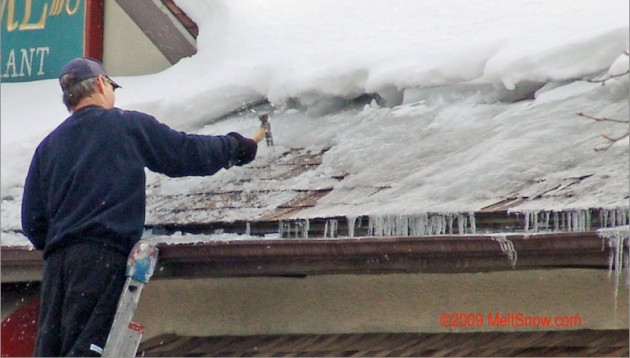
The winter of 2008-2009 has seen a return an old nemesis of building owners: ice dams. Heavy snowfall throughout New England has brought a rash of calls to our offices this season regarding how to melt ice dams that have formed on roofs and eves. Which deicer should I use? What is safe? What can I do to melt it and remove the problem? We offer a wide range of products which are often used (incorrectly) to melt ice dams; rock salt, sodium chloride, calcium chloride, magnesium chloride, blended products, and acetate based deicers are used to battle problems on the streets and sidewalks, but ice dam melting is tricky business and should not be entered into without careful evaluation of the pros, cons, and adverse consequences of your approach.
Ice dams are formed when melting snow turns to water which runs down a roof and then freezes as it leaves the warmer roof area of the building and enters the open area of the roof eve in sub-freezing temperatures. Ice dams usually occur after a heavy snowfall and several days of sub-freezing temperatures. Warm air inside your building or home leaks into the attic space and will warm the underside of the roof causing snow and ice on the roof to melt. The melted water will drain along the roof, under the snow, until it reaches the cold eve overhang. The eve overhang is usually at the same temperature as the outdoors and the melted water will refreeze and form an ice dam and icicles. The ice dam can cause damage to the roof, which will result in water leaks to the inside. Frequently the result will be a water spot on the ceiling under the roof damage, or water stains streaking down the inside wall. The water damage is not always obvious and may be hidden from view inside the wall, in the attic, or behind a knee wall. Depending up on the design of the building, ice dams may not be an issue and waiting out the problem could be the best answer if you are not getting any damage that warrants immediate action. On the other hand, if water is pouring down your wall and ruining it, then the decision process of what to do and understanding the potential adverse consequences of that action must be carefully evaluated.
Pictured below is a residence that is showing ice dams. If you study this photo, it shows very clearly how the ice dam is formed, and why.
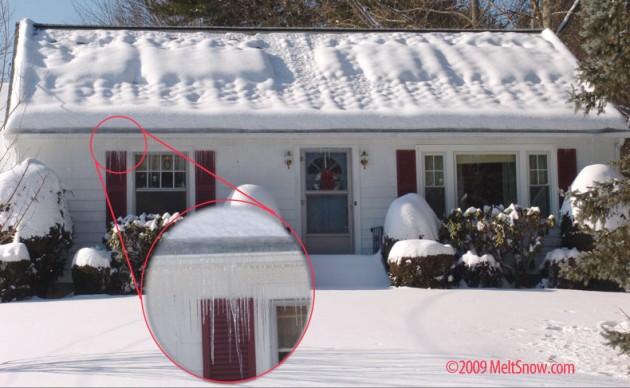
Notice how the rafters of the roof structure are silhouetted by the snowpack on the roof. That’s because warm air leaking into the attic space is in turn melting the snowpack on the roof, however the rafters are providing some level of insulation allowing the snow above them to melt at a much slower rate. There is a section of roof which is not melting in the center and that could be from a finished attic where that specific area was insulated, or possibly by insulated glass skylights that were installed, or it might be that insulation was applied to that area alone. Impossible to tell without getting inside this house and crawling into the attic with this photo to see why some areas have experienced heavy melting while others have not had much at all. In any case the areas of the house which are outside of the attic space, the edges, are still showing a full snowpack and therein lies the problem! Those areas are colder and any runoff of melting will freeze up when it collides with this cold area causing the ice dam.
As the water enters the cold gutter, it freezes. More water coming down the roof from the heat loss continues to freeze up until the gutter is filled and overflowing with ice and icicles. They continue to build up until they form a dam inches thick. Once the dam is high enough, the water on the roof collects and begins to seep under the roofing system and find its way into the building and then trouble begins.
With the basics of ice dams now understood, let’s talk about your chemical options to remove it. Just slather it in salt and the problem will go away, right? It should be so simple. Victims of ice dams need to consider all the factors involved in chemically attacking ice dams before they climb up on their roof like Santa and start pouring deicers on them. The varieties of roofing systems that are used in building present a range of considerations and challenges for openers. The first order of business is to evaluate the area of the ice dam as a whole. Is this a problem across the entirety of the structure or is it limited to one area like a valley above the roof overhang? What is the roof material? What is the fastening system used to hold the roof covering on? What is under the overhang where the chemical deicer runoff will go? Do you have plantings that might be damaged by chemical deicer runoff and could that runoff be more or less damaging then just waiting for the ice to melt and fall?
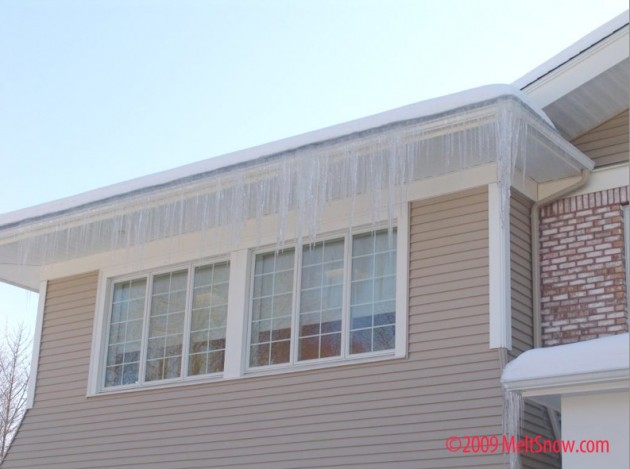
In the photo above we have a building with a very large overhang and significant ice dams and icicles. These pose a threat to pedestrians that use the sidewalk which is directly under this section of building so leaving them in place risks dropping a frozen dagger into someone’s head or shoulders. This particular building is a medical building where many elderly patients pass under these eves and risk of injury is pretty serious. In this case the threat is more falling ice than it is water entering the building…at least the time this photo was taken. Add a couple more feet of snow to this roof and the dynamic will change quickly as the tremendous weight load of 5-6″ of ice on the gutters and overhang threaten to test the engineer’s estimate, the builder’s skills, and insurance company’s budget.
Often it is believed that melting the ice dam with an ice melter is the right answer. Since we are in the business of selling ice melters, it’s hard for us suggest otherwise but experience has proven that ice melters on roofs can cause new types of damage which building owners need to consider before using them.
Pouring a granular deicer on the ice and scattering it across the whole area is a waste of deicer and it will likely not work unless you put enough deicer down to melt the volume of ice you have at the prevailing outside temperature. More to the point, an area of ice that is 50 feet long by 1 foot wide by six inches thick is 187 gallons of frozen water [(50×1.0.5)7.4 gallons/cubic foot] and will weight an astounding 1,560 lbs! That area is about equal to the edge of a roof eve. To melt 1500 lbs of ice, you would need to apply nearly 360 lbs deicer if you wanted to melt it at 16 degrees F. So realize we are talking about huge quantities of deicer that would be required to melt an amount of ice that big…and it’s not necessary. By comparison, you could break the underpinning or bond that the ice has on the surface it’s frozen to using only a fraction of that quantity with a careful “hole burning” approach.
Is your roof asphalt shingles? Most common high performance ice melters such as magnesium chloride or calcium chloride will certainly melt the ice, but they may also cause staining of the shingles and could also cause corrosion of the gutters, aluminum siding, or fasteners. Salt will leave a white residue and is very corrosive to unprotected ferrous metals so you might turn your black roof edge into a chalky mess with salt. Wooden gutters will be adversely affected by nearly all chloride deicers – so that knocks out use of rock salt (sodium chloride), calcium chloride, or magnesium chloride. Acetate deicers such as 100% pure CMA (calcium magnesium acetate) or NAC (sodium acetate) will not really work in melting ice. Other common deicers like urea (46-0-0 fertilizer) are only effective above 25 degrees Fahrenheit, and at that point you might as well wait out the remaining 7 degrees to thaw temp. If your roof is a standing seam tin roof, like the one pictured below, the same issues of possible staining or having the coating/paint lift from alkaline pH deicers is another concern.
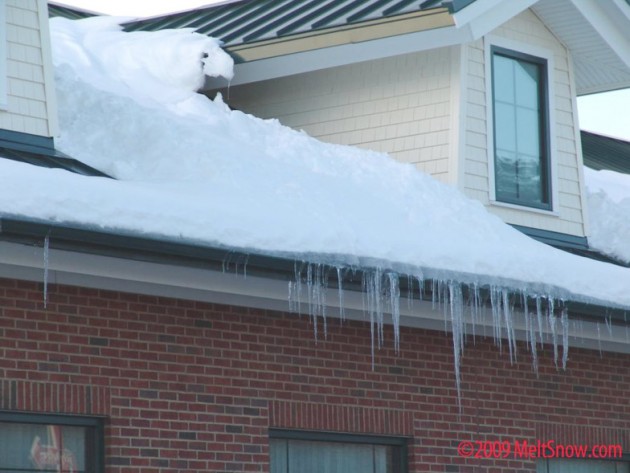
Maybe, but you have to weigh your options carefully. Which is the greater of the evils; the damage from the water leaking in, or the ice itself, or the potential damage from use of deicers?
Here’s a list of things to consider before you jump up there with a pile of fifty pound bags of ice melt and start pouring:
While we are not going to tell you to use chemical deicers on your roof, we will tell you that our ice melt products will melt ice and can turn that ice back into a brine. If you are trying to remove thick ice from a solid sloped surface, here are some tricks of the trade which will help you do it efficiently:
Pouring the ice melter or granular deicer on the ice and scattering it across the whole area is a waste of deicer and it will likely not work unless you put enough deicer down to melt the volume of ice you have at the prevailing outside temperature. More to the point, an area of ice that is 50 feet long by 1 foot wide by six inches thick is 187 gallons of frozen water [(50×1.0.5)7.4 gallons/cubic foot] and will weight an astounding 1,560 lbs! That area is about equal to the edge of a roof eve. To melt 1500 lbs of ice, you would need to apply nearly 360 lbs deicer if you wanted to melt it at 16 degrees F. So realize we are talking about huge quantities of deicer that would be required to melt an amount of ice that big…and it’s not necessary. By comparison, you could break the underpinning or bond that the ice has on the surface it’s frozen to using only a fraction of that quantity with a careful “hole burning” approach.
While I was taking photos for this article, I happened to drive by a local sandwich shop where a maintenance worker was using a claw hammer, a ladder, a pickup truck, and a little more aggressive mechanical approach to removing the ice dam. Here’s what he was doing:
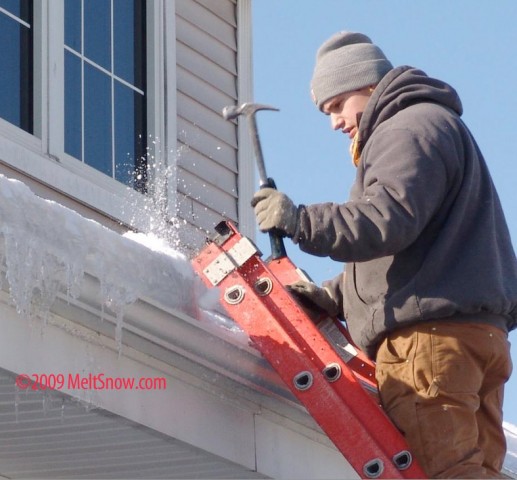
Looks like a good approach eh? Seems that he’s effectively chipping away the ice and saving the gutter and roof from water damage inside the building by removing the ice completely…right? Well maybe not.
As I looked at the ground under his ladder and on the sidewalk, I saw what he was actually removing along with the ice: THE ROOF! With each blow of the hammer, the ice’s hold on the roofing shingles was dear and it wasn’t leaving without the shingles that was frozen to, so both shattered together and went to the ground where he was sweeping them up and putting the ice and debris in the back of his pickup.
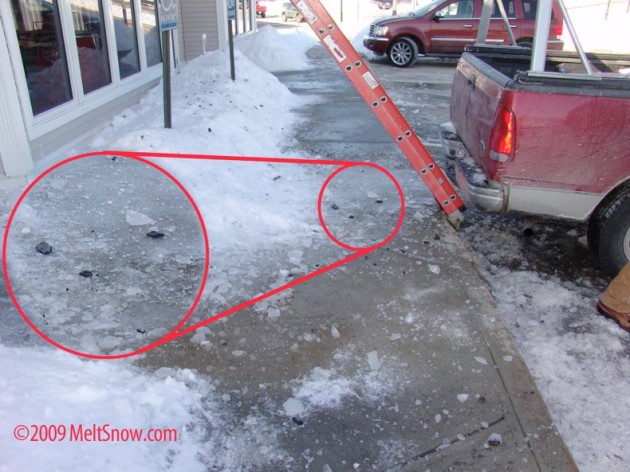
While at first glance this seems like an effective approach, the cost of replacing this section of roof in spring, plus the virtual guarantee of water damage from the now missing roof allowing water to get into the sheathing and eve might be a false economy. Remove the ice dam and replace the roof!
From my own experience, I can tell you that the best thing I’ve found for ice dams is to first remove the source; the snow above the eve must be shoveled off. Once that is done, assuming that action didn’t ruin the shingle system and roof which in my case the first time I did it, I did indeed destroy my own roof, then you can decide if leaving the ice there is going to cause any problems. If you were to use deicers to remove the ice dam and then didn’t remove the snow above the ice dam, then you can be assured the ice dam will return shortly as more melting snow comes sliding down the roof.
Installing heat tape or heating elements along the eve, and a moisture barrier along ice dam prone roof areas is a good idea and works well to prevent them from forming. An ounce of prevention is worth a pound of cure.
The safest and most innocuous high performance deicer we offer is our MAG Pellet. It’s low toxicity, low chloride, pet safe, and while we don’t suggest putting it on your cereal, in limited quantities it’s generally not damaging to most surfaces with the exception of NEW concrete. On new concrete do not use any deicers for two years minimum.
Deciding whether or not to attack an ice dam on your roof with a chemical deicer is a balancing act: you balance performance which is total removal of the ice dam, against adverse consequences such as staining of the roof system, loss of paint or coating on gutters and siding from runoff, damage to shrubs and turf under the roof when the concentrated brine hits them. Covering sensitive shrubs and the area under the ice dam with a tarp might be a good idea, but we want to be clear that we are not advocating the use of our products for removing ice dams as they are designed to work on pavement and traveled surfaces – not roof systems. If you were to use any of our products to remove ice dams, you would be doing so at your own sole risk and responsibility.
“He that will not apply new remedies must expect new evils”